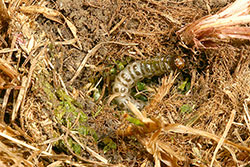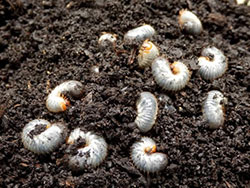What insects are injurious to a lawn?
Birds feeding in a lawn may indicate the presence of injurious insects like cutworms, webworms, billbugs, or white grubs. Most insects found in lawns are not harmful to the turf. When potentially harmful insects are feeding on the turf, their numbers are often not high enough to cause appreciable damage and to warrant an insecticide application.
What is the most common lawn insect?

The sod webworm is one of the most common lawn insect pest in the Rocky Mountain region. Adult webworms are small white and tan, torpedo-shaped moths which flit about the lawn during mowing during late spring and into summer. The adult does not feed on the lawn, but female moths lay eggs which hatch into small caterpillars.
Can my lawn have webworms and still survive?
Young webworms are small (1/4 to 1 inch long) caterpillars, brown or gray in color, and having rows of dark spots on their backs. During the day, young webworms live in silk-lined tunnels in thatch and the surface of the soil. At night they emerge from their tunnels to feed on grass leaves. Adequately fertilized and watered lawns are generally healthy enough to withstand substantial webworm populations – and feeding birds will often prevent the webworms from causing visible damage.
How can I get rid of webworms?
In the absence of feeding birds or when webworm numbers are high, a heavily infested lawn may not grow enough to require mowing and the grass may become noticeably thin. In severe cases some dead patches may develop. The presence of webworms can be easily confirmed by using a “revealing solution”. Mix a tablespoon of liquid dishwashing soap in a gallon of water and pour evenly on a 3 ft by 3 ft area of the lawn where you suspect an infestation. If webworms are present, the will come to the surface of the lawn within a minute or two. Webworms can be treated with any insecticide labeled for “lawn insect control”. If the use of natural/biocontrol products is preferred, parasitic nematodes and Bacillus-based bacterial insect control products can provide some control if applied to smaller, young webworms. If using biocontrols, follow instructions carefully to get the best results; purchase fresh product (check “use by” dates) and apply soon after purchasing it.
How can I recognize billbug damage?

Small dead patches of turf that can be easily pulled up in July and August may indicate feeding by white grubs or billbugs. To identify billbug damage, pull on the dead-looking grass stems. If the stems break off at the soil line and sawdust-like material is on the broken ends of the grass, the damage was caused by billbugs. Billbugs are relatively uncommon in Colorado lawns.
What do white grubs do to lawns?
White grubs feed on roots, which can result in large thinning and/or brown spots in the turf. The damaged turf can be easily peeled up from the soil surface – often revealing the presence of fat, C-shaped, whitish grubs (1/2 to 1 ¼ inch in length). Most lawns have a few white grubs in them, but suffer no visible damage. When population are high, however, large areas of turf can be killed. The presence of grubs (even when turf damage is minimal) can also be revealed by foraging raccoons and skunks – which will dig up large sections of lawns overnight in search of this favored food.
What can I do to keep white grubs out of my lawn?
The control of white grubs is more effective when they are younger and smaller – but before visible damage occurs on the lawn. By the time damage become noticeable, grubs are often so large that they are very difficult to kill with any lawn insecticide or natural/biocontrol product. If your lawn has a history of grub damage, the application of a lawn insecticide containing chlorantraniliprole (Scotts GrubEx) in June/early July will provide excellent preventative control of white grubs (and most other injurious lawn insects) into the fall period. Lesser levels of control can be obtained using lawn insecticide products containing imidacloprid, thiamethoxam, clothianidin; apply these in mid to late June. Natural/biocontrol products containing Heterorhabditis nematodes, or Bacillus thuringiensis galleriae (grubGONE!), can be effective non-chemical options for white grub control.
For more information, see the following Colorado State University Extension fact sheet(s).



